A Perspective on Locken Chinchillas

(above) Dr. Jackie & Sharon of Studio Arashi Chilla, Hong Kong
Dr. Jackie TK Cheung is a primary care doctor with postgraduate training in underwater medicine. Further, he has been keeping chinchillas as pets for 20 years. He is self-taught in matters pertaining to the scientific aspects and diseases of chinchillas. With numerous hands-on experiences in dealing with common presentations and rather rare disease entities, he has both shared his experiences and learned from others. In recent years, Dr. Cheung has dedicated much attention to the improvement of the Locken mutation, including the design and construction of a custom studio to house these special chinchillas. He attributes his development of the Lockens to sharing with, and learning from breeders in the USA, Belgium, Poland, and Russia.
A Perspective on Lockens
by Dr. Jackie TK Cheung | October 18, 2024
The JC & S herd was founded in 2018, as an enthusiastic operation dedicated to the advancement of the remarkable locken breed. Please find some thoughts and observations following.
Well-maintained locken fur will have almost the same softness and smoothness as non-lockens. Even the extreme curly fur under good care will still feel as silky and smooth as non-curly or Royal Persian Angora (RPA) chinchillas. Curly is the look, but not the texture. 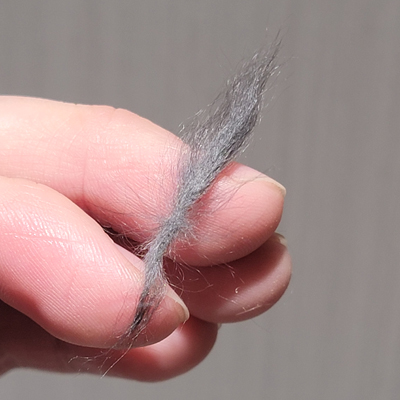 The feeling of knots over locken fur serves as an early warning of mattes developing. In order to keep the fur from becoming matted, provide regular dust baths and regular grooming with good combs. Don’t let matted or knotted fur get started. It may not be a wise strategy to keep the fur looking curly by limiting dust baths, though it may work in the short term. And it is better to release or remove any knotted fur before dust bathing. Proceeding to a dust bath with matted curly fur will more likely worsen the situation with the accumulation of dust and debris around the knots. A good curly pattern won’t lose form by frequent bathing and gentle grooming. A well maintained curly will stand apart from a chinchilla with murky fur.
The feeling of knots over locken fur serves as an early warning of mattes developing. In order to keep the fur from becoming matted, provide regular dust baths and regular grooming with good combs. Don’t let matted or knotted fur get started. It may not be a wise strategy to keep the fur looking curly by limiting dust baths, though it may work in the short term. And it is better to release or remove any knotted fur before dust bathing. Proceeding to a dust bath with matted curly fur will more likely worsen the situation with the accumulation of dust and debris around the knots. A good curly pattern won’t lose form by frequent bathing and gentle grooming. A well maintained curly will stand apart from a chinchilla with murky fur.
If you simply like the curly fur pattern (high degree of curl), then it is better not to add RPA expression, unless you are well prepared for the heavy maintenance. But if you like angora chinchillas and are looking for variation apart from hair length or ear tufts, adding a taste of wavy hair to the body and tail can actually be an option.
Many think of the inheritance of locken genomes by comparing it with the case of ebony chinchillas.
Think in this way: ebony genes are at least responsible for two phenotypes:
1.) color factor that gives the ebony dark color in different degrees (carrier/light to extra dark)
2.) wrapping factor that lets the fur in the belly develop color instead of white.
The wrapping factor looks like a yes or no switch in most situations. The color factor appears dominant cumulative. It is assumed to be the major variable that determines the phenotypic classification of the ebony chinchilla.
Comparable to this line of thinking, the locken phenotype needs the wrapping factor that, by consensus, is from the ebony influence, being ebony or ebony carrier.
 The degree of curl is the variable that is determined by other locken genes in a presumably cumulative dominant pattern. Overall inheritance is polygenic in that sense: the phenotype results from the influence of multiple genes and the different combinations.
The degree of curl is the variable that is determined by other locken genes in a presumably cumulative dominant pattern. Overall inheritance is polygenic in that sense: the phenotype results from the influence of multiple genes and the different combinations.
This may explain why breeding the locken mutation is still full of challenges.
There is so far no standardized classification of curly chinchillas phenotype. Different breeders may mean different extents of the locken gene expression by quoting one as curly chinchilla. The appearance of curly fur over the belly is the common finding. The higher degree of curl over the belly seems also very consistent with any high degree of curl over the trunk. Yet the extension of the curl from the belly to the rest of the trunk is not always correlating to the degree of the curl, ie., one can have a low or moderate degree of curly fur involving the whole torso. To the extreme end, we can have tightly curl expression that some use the term “afrocurly” to appreciate the amazing pattern. The degree of ebony color does not seem to impose a major influence on the degree of curl. We can have a very good curl degree in a standard ebony carrier (white belly).
In order to better appreciate the possible variation, it may be good to describe separately the 1) degree of curl, 2) extent of coverage, and 3) curly expression in whiskers and tail hair.
The degree of curl from birth to adulthood is not always a fixed one. The extreme tight curly pattern (“afrocurly”) will appear from birth and continue to express the high degree of curl later on. Newborns with highly wavy or curly fur may lose the degree of curl to a different extent when growing up. Yet the degree of curl in some less curl newborns can grow up with more obvious curly expression. The degree of curl in the belly appears to be a good indicator for the potential of an individual.
The coverage of fur with the curly pattern starts from belly to chest. The more expressed one will have the curl also around the neck circumference and also the hind limbs. The “full” coverage will show the curly fur in the whole torso up to the back.
The wavy whiskers may appear very subtle, even in a chinchilla with a very curl appearance. And very prominent curly whiskers also may not mean the fur is of very high curl expression.
A simple grading scale comparable to the more commonly adopted ebony mutation classification can be proposed as a reference:
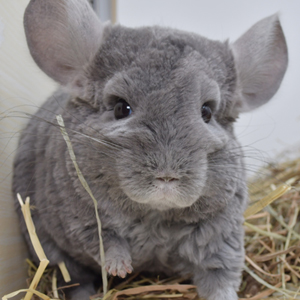
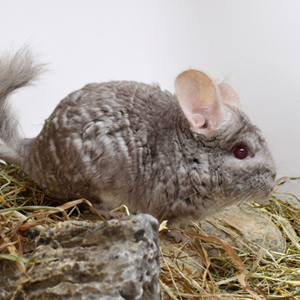
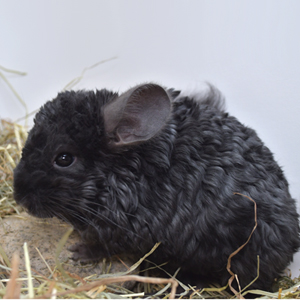
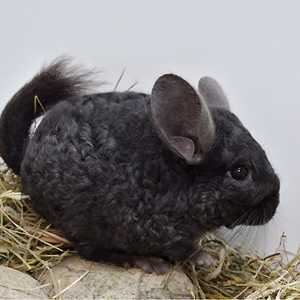
(left to right) Wrap Violet Locken carrier / light degree curly, Tan Locken moderate degree curly, Ebony Locken high degree curly, Ebony Locken highly tight curls (“afrocurly”)
From observation, the addition of RPA expression to a locken chinchilla, called Royal Imperial Angora (RIA) or curlygora, will result in different degrees of curly fur in a difficult to predict manner. In most cases, the RPA expression will easily be predominant, and the locken expression will show as light or obvious wavy fur, some curly tail hair and a possible curl in some vibrassae. In exceptional cases, the high degree of curly fur can be expressed together. The resulting curlygora needs meticulous and frequent fur maintenance compared to others.
With the existing herds of this mutation, most will agree that the best curly chinchillas cannot result simply from pairing a high degree curly with another high degree curly individual, despite the presumed cumulative dominant pattern of locken genes.
The conformation and body weight of curly chinchillas are remarkably improved with the contributions of many breeders in different countries. We can now see more quality curly chinchillas in different color combinations. The establishment of a more consolidated locken phenotype is yet a long way to go. The exciting moment of having a little merino rodent born will continue.
